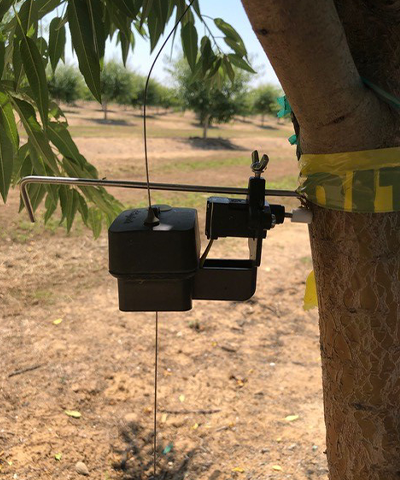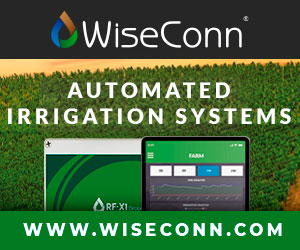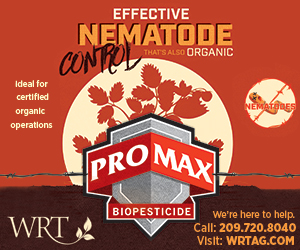When do growers need to irrigate and for how long? This is a question growers have been asking for years. The answer, though, is not as simple as the question. With a wide array of crops, soil types, irrigation methods and climates all playing factors in the answer to the question, we turned to key almond professionals in the irrigation industry to get some answers.
Ethan Nicol, an Independent Crop Advisor, started looking at irrigation technology methods in 2015 when working for a family farm in Kern County. They were transitioning from flood irrigation to double line drip, and Nicol was searching for a method to correlate soil moisture with irrigation success.
“We looked at a variety of tensiometers and other tools,” Nicol said. “But at the end of the day, the questions were still, ‘are we effectively irrigating or not?’”
This lingering question brought Nicol to his Almond Board Leadership Program class project, where he experimented with dendrometers on two different varieties of almonds.
“Hardshells were much more prone to stress, even though they were receiving the same amount of water as the Nonpareils,” he explained.
Nicol’s project measured the contraction and expansion of the tree trunk utilizing the dendrometer data.
“The dendrometers showed we needed to make irrigation changes,” he said. “By shifting 20% of the water from Nonpareils to hardshells, we were able to increase hardshell yield by 20-30%.”
This shift in irrigation Nicol did was halfway through the growing season.
“Imagine if you make those adjustments earlier in the season,” he said. “Growers can save water and increase their yield just by managing their tools to irrigate effectively.”
Nicol was literally able to have his switch pay off with a higher yield.
Trusting the Data
With multiple tools and methods on the market, it is hard to determine which one or combination of numerous will work for your farm. Once a grower commits to a company or technology, how will they know it is working?
Trust is one element that Tom Devol, Senior Manager of Field Outreach & Education at Almond Board of California, says plays a significant role.
“Growers won’t believe the data if it is counter to what your intuition is telling you,” Devol said. “I have seen so many growers make countless mistakes because they don’t trust their sensors. If the data doesn’t make sense, go to the field.
Trusting the data that comes along with the technology is step one. Growers often need to validate the data with old fashioned methods they know are proven. Waiting until harvest and watching the benefits pay off or not could be too late.
Devol suggested soil logging as an excellent check to ensure the data is correct. Irrigation needs can be contingent upon a variety of different methods and tools.
“Using a soil probe to the depth of 3 to 4 feet, growers can achieve the best validation of any data,” he said. “Growers can touch the soil and feel the moisture to know if the data is right. If the data doesn’t make sense to the grower, go to the field.”
Volume Metric Sensors
“Capacitance probes send an electronic pulse through the soil until it finds moisture and measures how long it takes to gather a reading,” Devol continued. “Profile probes have multiple sensors across the probe and down the probe’s length through the soil. Usually, growers are using a 3- to 5-foot-long probe with three to 12 sensors down the probe.”
Visually, a grower can see how much water is in the ground and if he needs to fill it back up.
“Probes can tell you how long it takes to get water through the various depths of the soil,” he said.
Probes are the most-used irrigation technology method in tree crops. They show what growers are looking for and are the easiest method to understand needs. Using probes, growers are purely gauging moisture in the ground.
Tension-based Technology
Tension-based sensors are an alternative to looking at how much water is in the soil.
“Tensiometers are the methods growers have been using the longest to determine irrigation needs,” Devol explained. “Tensiometers use suction to measure the tension used to pull water out of the soil. It measures how much force the root uses to draw water. Tensiometers range to -85 kilopascals, though. When deficit irrigating, it is hard to evaluate when there is no water in the profile. This can be a challenging method to evaluate during hull split.”
Watermark or water potential systems are other tension-based methods growers can utilize with a higher kilopascal measurement than a tensiometer.
“A watermark still reads tension but can go up to -300 kilopascals, or a water potential system can read up to -1500 kilopascals,” Devol said. The kilopascal measures the stress or pressure the plant is under. The more precise number, the better a grower can understand the severity of plant stress that may be present in their orchard.
Plant-based Systems
In addition to below-ground approaches, there are also irrigation tools using for above-ground techniques. Measuring plant stress is an alternative way to determine irrigation needs. Ethan Nicol suggested measuring the plant’s stress as well as the soil.
“When evaluating soil moisture, we rely on a few square feet to interpret water needs for the entire orchard,” Nicol explained. “Measuring the plant itself, we measure the root system and the plant characteristics—variable canopy size, vigor, rootstock and limitations in the soil.”
By first taking a satellite image of the orchard, growers can identify the most uniform representation of the orchard to determine the ideal location for the dendrometer sensors. Nicol recommends three dendrometers on three different trees for every 80 acres.
“The sensors will measure the tree as the sun comes up and as temperatures increase,” he said. “This helps to gauge the rate of water loss through the canopy. This is compared to the rate the tree is pulling water through the soil—is the tree using stored water reserve to get through the day? The size of the contraction is what we use to measure plant stress.”
Growers can use the data to successfully monitor plant stress. The data is collected every 15 minutes and the grower can analyze this data the following day to ensure minimal plant stress.
“Using observed ETo, water applied and the plant status feedback provided by the dendrometers, we can establish an effective crop coefficient for each plot being monitored,” Nicol explained. “For example, if ETo is 1.8 inches and you apply 1.8 inches (100% of ETo), and as a result the trees experienced moderate to severe stress, the dendrometer technology tool will increase that plot’s ET coefficient from 100% of ETo to, say, 110% of ETo for the next week depending on the severity of the stress.”
Nicol said this system can be used to effectively create irrigation scheduling.
Pressure bombs are an alternative method for accurately measuring plant stress on a smaller scale. This can be an effective way to check your data but is not practical on a large-scale method.
“A single leaf can be collected and wrapped to shut down photosynthesis for 10 minutes,” Nicol explained. “Place the leaf in a pressure chamber, tighten the petiole, and connect to a CO2 tank to increase the pressure in the chamber. Once water is forced out of the leaf, it has reached its stress point.”
Alternative Methods
Devol pointed out a few additional techniques that may work in conjunction with the mentioned tools. Utilizing multiple approaches that work together can provide effective tools for making irrigation decisions.
“Weather stations tell you actual conditions; how much was consumed and how much you need to replenish,” he said. In correlation with another method, this could lead to a check and balance tool.
“Aerial imaging is also a way to measure actual evapotranspiration. This approach gives you the complete orchard scope and not just spots of the field where a probe or sensor may be.”
This approach may also be a good beginning step for methods requiring a big-picture approach. Understanding soil characteristics across the fields as well as under the soil, together, play essential roles.
“It’s not one or the other,” Devol said. “Multiple tools can work together to answer the underlying question. When do growers need to irrigate and for how long?”
With multiple tools in the grower’s irrigation wheelhouse, there can be an overload of data and information at his fingertips. When the technology becomes too much for a grower to handle, it isn’t helpful. Devol said that is a common issue with irrigation technology.
“Are these tools requiring growers to become data analysts? If the data is up to interpretation, the data can be ineffective.”
Advancements sometimes overcomplicate and lose sight of the big picture. All these tools are helpful and really do make an impact on irrigation decisions. The main focus, though, is can the tool ensure the answer that original question—”When do growers need to irrigate and for how long?”













